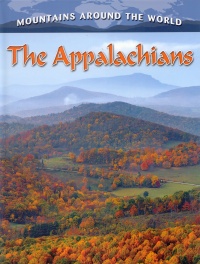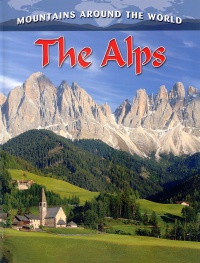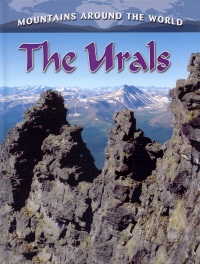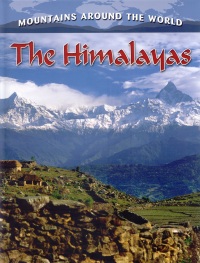| ________________
CM . . .
. Volume XVIII Number 25. . . .March 2, 2012 
 |
The Rocky Mountains. (Mountains Around the World).
Molly Aloian.
St. Catharines, ON: Crabtree, 2012.
48 pp., pbk. & hc., $11.95 (pbk.), $21.56 (RLB.).
ISBN 978-0-7787-7570-6 (pbk.), ISBN 978-0-7787-7563-8 (RLB.).
Subject Headings:
Rocky Mountains-Juvenile literature.
Natural history-Rocky Mountains-Juvenile literature.
Grades 5-8 / Ages 10-13.
Review by Sherry Faller.
**** /4
|
| |
|
 |
The Appalachians. (Mountains Around the World).
Molly Aloian.
St. Catharines, ON: Crabtree, 2012.
48 pp., pbk. & hc., $11.95 (pbk.), $21.56 (RLB.).
ISBN 978-0-7787-7568-3 (pbk.), ISBN 978-0-7787-7561-4 (RLB.).
Subject Headings:
Appalachian Mountains-Juvenile literature.
Appalachian Region-Juvenile literature.
Appalachian Mountains-Environmental conditions-Juvenile literature.
Grades 5-8 / Ages 10-13.
Review by Sherry Faller.
**** /4
|
| |
|
 |
The Andes. (Mountains Around the World).
Molly Aloian.
St. Catharines, ON: Crabtree, 2012.
48 pp., pbk. & hc., $11.95 (pbk.), $21.56 (RLB.).
ISBN 978-0-7787-7567-6 (pbk.), ISBN 978-0-7787-7560-7 (RLB.).
Subject Headings:
Andes-Juvenile literature.
Andes-Environmental Conditions-Juvenile literature.
Grades 5-8 / Ages 10-13.
Review by Sherry Faller.
**** /4
|
| |
|
 |
The Alps. (Mountains Around the World).
Lynn Peppas.
St. Catharines, ON: Crabtree, 2012.
48 pp., pbk. & hc., $11.95 (pbk.), $21.56 (RLB.).
ISBN 978-0-7787-7566-9 (pbk.), ISBN 978-0-7787-7559-1 (RLB.).
Subject Heading:
Alps-Juvenile literature.
Alps-Environmental conditions-Juvenile literature.
Grades 5-8 / Ages 10-13.
Review by Sherry Faller.
**** /4
|
| |
|
 |
The Urals. (Mountains Around the World).
Robin Johnson.
St. Catharines, ON: Crabtree, 2012.
48 pp., pbk. & hc., $11.95 (pbk.), $21.56 (RLB.).
ISBN 978-0-7787-7571-3 (pbk.), ISBN 978-0-7787-7564-5 (RLB.).
Subject Headings:
Ural Mountains (Russia)-Juvenile literature.
Ural Mountains (Russia)-Environmental conditions-Juvenile literature.
Grades 5-8 / Ages 10-13.
Review by Sherry Faller.
**** /4
|
| |
|
 |
The Himalayas. (Mountains Around the World).
Molly Aloian.
St. Catharines, ON: Crabtree, 2012.
48 pp., pbk. & hc., $11.95 (pbk.), $21.56 (RLB.).
ISBN 978-0-7787-7569-0 (pbk.), ISBN 978-0-7787-7562-1 (RLB.).
Subject Headings:
Himalaya Mountains-Juvenile literature.
Himalaya Mountains-Environmental conditions-Juvenile literature.
Grades 5-8 / Ages 10-13.
Review by Sherry Faller.
**** /4
|
| |
|

excerpt:
What is a Mountain?
A mountain is a gigantic natural landform that rises above Earth's surface. A mountain often has steep sides rising to a summit, which is the highest point or peak. Mountains are usually found in long ranges or groups of ranges called chains. They are formed in different ways, but most of the mountains on Earth have formed over millions of years. You may not be able to notice or feel it, but mountains are forming even as you read this book!
Have you ever gazed up at a mountain in wonder? How was such a majestic structure formed? How high is it? Can it be climbed? This series of six books describes how each range was formed, the weather found over and around it, and the plants and animals that have adapted in order to survive on it. Readers interested in earthquakes and volcanoes will love these books. They are also an excellent resource for habitat research projects. People live on all the ranges and make their living by extracting the natural resources and through tourism. Mountains also have features that are at risk, and procedures to protect the mountain ranges are outlined.
Each book in the "Mountains Around the World" series has a timeline dating back to around 200 million years ago! The usual Crabtree table of contents, glossary and index are included as well as a short list of other books to read and websites to search. Fast facts about the ranges are splashed in a corner of several pages. The Earth's tectonic plates are mapped, explaining the constant movement of mountains.
The Rocky Mountains explains that this range is among the youngest mountains in North America. They are still moving and changing slowly through ice ages and by the melting of glaciers. The Continental Divide section explains why rivers originating in the Rockies flow in different directions. Of interest are the sections on the indigenous people who live there and explorers who charted the range. The Rockies are important for the minerals and oil and national parks found there.
The Appalachians are a natural barrier between the eastern coastal plains and the interior lowlands of North America. They were built by the movement of the tectonic plates and are composed of igneous and metamorphic rocks. Logging, coal mining and manufacturing are the major economic advantages of the range.
The Andes are the longest mountain range in the world, stretched the full length of South America. This range was formed by volcanic eruptions and worn by grinding glaciers. The history of the Inca Empire and the Spanish exploration are explained, and the weather extremes from desert to rainforest spark the reader's intrigue. Mining, agriculture and national parks are the major economies of the area.
The Alps are the largest and most popular range in Europe. The range was formed by the folding of mountains, and glaciers and moraine lakes abound. Hiking is popular through the many passes and tunnels. The Matterhorn is the highest peak, topping at over 4000m above sea level. Many archaeological discoveries of ancient weapons and tools have been found on the range.
The Urals split the continents of Europe and Asia. This range is one of the oldest and lowest in the world. It was formed when surfaces were pushed, bent and folded, and sedimentary rock is plentiful. The Kengur Ice Cave is one of the longest caves in the world, and interesting cave paintings have been found in the area.
The Himalayas have the highest mountains on the globe, with Mount Everest being the tallest and the one mountaineers most long to climb. This range separates the Indian sub-continent from the Tibetan Plateau. The range was formed by tectonic plate movement with many earthquakes. Climbers are fascinated by the fossils found at high altitudes. Forestry, mining, agriculture and the fruit and sugar industries provide the economy for those who live in the mountain range.
"The Mountains Around the World" series is highly recommended for use in middle schools.
Highly Recommended.
Sherry Faller is a teacher-librarian in Winnipeg, MB.

To comment
on this title or this review, send mail to cm@umanitoba.ca.
Copyright © the Manitoba Library Association. Reproduction for personal
use is permitted only if this copyright notice is maintained. Any
other reproduction is prohibited without permission.
NEXT REVIEW |
TABLE OF CONTENTS FOR THIS ISSUE
- March 2, 2012.
AUTHORS |
TITLES |
MEDIA REVIEWS |
PROFILES |
BACK ISSUES |
SEARCH |
CMARCHIVE |
HOME |





